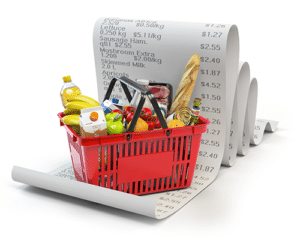The retail landscape is changing – dramatically. To really compete, you need to make sure your store is in the best possible shape.
Shopping habits have shifted as a result of the cost of living crisis, which is driving many shoppers to opt to shop locally, little and often, for more frequent top-up shops. But the multiples and discounters alike are ramping up activity, and lowering prices, to compete.
Whilst it is a difficult time for smaller players in retail, navigating through a perfect storm of challenges; margin maintenance, store theft, staffing issues and challenges of availability and finding the stock they want, to name a few. But it’s also a huge opportunity. Being local and convenient are two key attributes but to really compete, you need to make sure your store is in the best possible shape and you are playing to your convenience strengths.
Partners for Growth, the trusted support programme for convenience retailers can help. Besides free and impartial advice on category management, merchandising and layout, the programme’s Retailer Advisory Panel meets regularly. These experts are experienced, successful retailers at the forefront of developments in the convenience sector, and they want to help their fellow independents innovate and grow their sales.
The panel have focused on today’s big challenges and identified the top priorities for smaller players. Following their clear, easy-to-implement advice is like having your very own team of personal retail ‘fitness trainers.’
- Have a plan – planning is key to the success of any business, and a business plan should be the foundation. Retailer Advisory Panel member Kishor Patel says: “By putting a business plan in writing, with your objectives, business strategy and action plan clearly laid out, you set yourself a course to follow. It also serves as a valuable business tool to benchmark your achievements against”. Action: If you don’t already have a business plan, download the Business Plan template and get started.
- Assess the competition – understand who you are competing with and look at what they do well. Remember the competition may vary at different times of the day – in the evenings, for example, you may be competing with a takeaway or chippie for the ‘meal for tonight’ spend. Action: Visit stores or outlets in the area to see what they are doing differently, or chat with other retailers at the cash & carry to understand what works for them.
- Offer value for money – Price-marked packs, promotions and a range that suits your shoppers can all help but for convenience shoppers, the concept of value is not just about price. Ease of shop, good customer service, a value range, and good stock availability all help to convey a sense of value. Action: Why not create a value offers/£1 fixture to reinforce the perception of value, and sell through slower sellers at reduced prices? Additionally, why not run a customer survey to see what your store could also benefit from in order to better suit your shoppers needs.
- Make the most of staff – Friendly, helpful staff create a positive experience for customers. Service needs to be quick and efficient but, more importantly, executed with a positive, helpful attitude. And, besides the staff representing the store and its values, they interact daily with consumers and view the store in very different ways from management. Ensure they feel valued, have regular appraisals and listen carefully to their thoughts and ideas and pay them well so that they remain loyal and aren’t tempted to leave to work elsewhere . Action: Use the staff appraisal form with your staff, and take the opportunity to get their ideas on improvements.
- Make the store look great – By having a welcoming, clean, bright store which provides your customers with a pleasant place to shop, they will want to come back. A clear layout, which helps customers fulfil their missions is also crucial. Action: Give your store a spring clean, and view it from a customer’s perspective. Check out the research Unilever did on shopper missions and how to achieve the perfect store to ensure you’re maximizing the layout of your store.
- Get involved in the community – Boost local customer loyalty by placing the store at the heart of the community. By getting involved in community activities such as summer fairs, a bonfire night or by sponsoring a local football team, you will position yourself at the heart of the community. When shoppers are deciding where to shop, this will be a factor. Action: Ask your customers which events they support, and see how you can get involved – download the Holding Community Events Fact Sheet
- Understand your business fundamentals – With the rise in prices its never been more important to really understand your business’s bottom line, because otherwise you really could be moving backwards. So keep a focus on the number of customers per week, average basket spend, gross profit margins by products so you can delist slower sellers or products with poor margins and so on. Without this information, it’s tough to maximise profits when prices are changing so frequently. Action: Use till data to work out these key figures and use the Profit Calculator to help you work out crucial profits and margins.
- Join a symbol group –This can differentiate your store from the competition, raise customers’ quality expectations and the branding can be a magnet. This may not be the way to go if you want to stock large ranges of niche or local products but some groups are recognising that more range flexibility and catering to an area’s demographic can make the shop a ‘destination store’. They can also help you with store refits so if you aren’t already with a symbol group, it might be time to revisit the topic and do your own assessment on the pro’s and cons of doing so. Action: Have a look around and consider which symbol group best fits your store affluence, location and offering. Contact two or three symbol groups to see which offers you the best package of support. Once you’ve narrowed it down, it might pay to talk to other retailers to see what their experience is of the symbol group you are thinking of joining.
Who are the Retailer Advisory Panel?
Launched in 2009, the Retailer Advisory Panel, plays an integral part of the Partners for Growth programme in helping convenience retailers improve their overall business performance, as well as their category performance.
The panel is made up of seven highly experienced, award-winning retailers who represent the spectrum of convenience retailing and meets regularly. They are committed to excellence and work with Partners for Growth to offer fellow independent retailers their invaluable industry, business and retail insights, together with mentoring support.
The award-winning members are – David Charman, Dean Holborn, Jonathan James, Ramesh Shingadia, Kay Patel, Kishor Patel and Mandeep Singh and the latest addition to the panel Sue Nithyanandan – have been selected because they have been recongnised by the industry, for their best practice in retailing, merchandising and store layout, and are at the forefront of identifying ways to develop the convenience sector. They have walked the walk, so it pays to listen to them when they talk the talk!





82 Responses
h5jmmt
s643o0
phsfxj
koybk4
sqpni0
wfv0j8
3ys062
ax0idw
ku0xnt
516ddp
qqbie9
rmnba3
21oknd
3l8563
wuac3w
oi5421
ago8lb
h7nq2x
pr9b1d
ee7esk
Keep functioning ,impressive job!
Today, I went to the beach front with my children. I found a sea shell and gave it to my 4 year old daughter and said “You can hear the ocean if you put this to your ear.” She put the shell to her ear and screamed. There was a hermit crab inside and it pinched her ear. She never wants to go back! LoL I know this is completely off topic but I had to tell someone!
Great awesome issues here. I am very happy to peer your article. Thank you a lot and i am having a look ahead to contact you. Will you please drop me a e-mail?
This is the correct weblog for anybody who desires to seek out out about this topic. You realize so much its virtually arduous to argue with you (not that I really would want…HaHa). You positively put a brand new spin on a topic thats been written about for years. Nice stuff, just great!
Very interesting information!Perfect just what I was searching for!
Once I originally commented I clicked the -Notify me when new comments are added- checkbox and now each time a comment is added I get four emails with the identical comment. Is there any means you’ll be able to remove me from that service? Thanks!
I’m still learning from you, as I’m trying to achieve my goals. I definitely love reading all that is written on your website.Keep the tips coming. I enjoyed it!
I like this site its a master peace ! Glad I observed this on google .
Hey there! This post could not be written any better! Reading this post reminds me of my old room mate! He always kept talking about this. I will forward this page to him. Pretty sure he will have a good read. Thanks for sharing!
I¦ve learn several good stuff here. Certainly worth bookmarking for revisiting. I wonder how much attempt you place to create any such wonderful informative website.
Hello! This is my first visit to your blog! We are a group of volunteers and starting a new initiative in a community in the same niche. Your blog provided us valuable information to work on. You have done a marvellous job!
Hello.This article was really fascinating, particularly since I was investigating for thoughts on this topic last Thursday.
An fascinating dialogue is worth comment. I feel that you should write more on this subject, it might not be a taboo topic however generally individuals are not sufficient to speak on such topics. To the next. Cheers
7yrgd5
Its wonderful as your other articles : D, thankyou for putting up.
I see something genuinely interesting about your site so I bookmarked.
x6n429
75f788
p24arj
4uqu8z
Wonderful work! That is the type of info that should be shared around the web. Disgrace on Google for now not positioning this publish higher! Come on over and discuss with my website . Thanks =)
Perfect piece of work you have done, this site is really cool with good information.
Thank you a lot for providing individuals with a very terrific possiblity to check tips from this web site. It can be very fantastic and also stuffed with amusement for me and my office fellow workers to visit your site at the very least three times every week to read the newest tips you will have. And definitely, we’re always pleased with your terrific tactics you serve. Selected two points in this posting are clearly the very best we have had.
I’m usually to blogging and i really respect your content. The article has actually peaks my interest. I am going to bookmark your website and preserve checking for brand new information.
1gsv0f
I believe other website owners should take this site as an example , very clean and great user pleasant design.
hi!,I like your writing very so much! percentage we be in contact more approximately your article on AOL? I require a specialist in this area to unravel my problem. Maybe that’s you! Looking ahead to see you.
nfaz1n
I am thankful that I found this web site, just the right information that I was searching for! .
I was examining some of your blog posts on this internet site and I believe this internet site is real informative! Keep putting up.
As a Newbie, I am continuously searching online for articles that can help me. Thank you
Hello, i think that i saw you visited my web site thus i came to “return the favor”.I’m attempting to find things to improve my site!I suppose its ok to use a few of your ideas!!
Very interesting subject , thanks for putting up.
There are some interesting points in time on this article but I don’t know if I see all of them heart to heart. There’s some validity but I will take hold opinion until I look into it further. Good article , thanks and we wish more! Added to FeedBurner as effectively
I believe you have noted some very interesting points, thanks for the post.
Hi there! This post couldn’t be written any better! Reading through this post reminds me of my previous room mate! He always kept talking about this. I will forward this article to him. Pretty sure he will have a good read. Thank you for sharing!
UK Personal Protection Ltd offers SIA-licensed bodyguards for hire in London, across the UK, or worldwide. Their operatives are highly trained in close protection, anti-ambush, hijack response and first aid, delivering confidential, bespoke security solutions to VIPs, executives, diplomats, and high-risk individuals.
I was curious if you ever thought of changing the page layout of your website? Its very well written; I love what youve got to say. But maybe you could a little more in the way of content so people could connect with it better. Youve got an awful lot of text for only having 1 or 2 images. Maybe you could space it out better?
It¦s actually a great and useful piece of information. I am satisfied that you simply shared this helpful information with us. Please keep us informed like this. Thank you for sharing.
What does a Farmasi Europa Beauty Influencer account mean? Earn money at your own pace and personally with Farmasi Europa. Five major European countries have joined Farmasi Europa: Spain, Great Britain, France, Italy, Portugal. A bunch of countries that have accumulated tens of thousands of Farmasi Europa beauty influencers.
I loved as much as you will receive carried out right here. The sketch is attractive, your authored subject matter stylish. nonetheless, you command get got an edginess over that you wish be delivering the following. unwell unquestionably come more formerly again since exactly the same nearly a lot often inside case you shield this increase.
I’m not sure why but this web site is loading very slow for me. Is anyone else having this issue or is it a problem on my end? I’ll check back later and see if the problem still exists.
Nutriplus Farmasi.com.ro suplimente alimentare și de sănătate unice pe piața din Europa. Ofertă unică pe piața suplimentelor din Europa: Nutriplus cu susținerea sănătății și a frumuseții din interior. Alege farmasi.com.ro pentru produsele Nutriplus România!
Can I just say what a relief to find someone who actually knows what theyre talking about on the internet. You definitely know how to bring an issue to light and make it important. More people need to read this and understand this side of the story. I cant believe youre not more popular because you definitely have the gift.
I was very happy to find this net-site.I wanted to thanks on your time for this glorious learn!! I definitely enjoying each little bit of it and I’ve you bookmarked to take a look at new stuff you blog post.
Very interesting subject, thank you for putting up.
Wonderful blog! I found it while browsing on Yahoo News. Do you have any suggestions on how to get listed in Yahoo News? I’ve been trying for a while but I never seem to get there! Cheers
You made some clear points there. I looked on the internet for the subject and found most people will consent with your website.
Great website. A lot of useful information here. I’m sending it to some friends ans also sharing in delicious. And of course, thanks for your sweat!
The other day, while I was at work, my sister stole my iPad and tested to see if it can survive a twenty five foot drop, just so she can be a youtube sensation. My iPad is now destroyed and she has 83 views. I know this is entirely off topic but I had to share it with someone!
But a smiling visitant here to share the love (:, btw outstanding design and style.
I always was concerned in this subject and stock still am, appreciate it for posting.
I think other website proprietors should take this website as an model, very clean and fantastic user friendly style and design, as well as the content. You’re an expert in this topic!
Thanks for every other magnificent post. Where else could anybody get that kind of information in such a perfect means of writing? I’ve a presentation next week, and I’m on the look for such information.
Terrific work! This is the type of info that should be shared around the internet. Shame on Google for not positioning this post higher! Come on over and visit my site . Thanks =)
I truly appreciate this post. I’ve been looking everywhere for this! Thank goodness I found it on Bing. You have made my day! Thx again!
Wohh exactly what I was searching for, thankyou for putting up.
Wonderful beat ! I would like to apprentice while you amend your web site, how could i subscribe for a blog site? The account helped me a acceptable deal. I had been tiny bit acquainted of this your broadcast provided bright clear concept
I?¦ll immediately clutch your rss feed as I can not in finding your e-mail subscription hyperlink or newsletter service. Do you have any? Please let me recognise so that I could subscribe. Thanks.
We are a bunch of volunteers and starting a new scheme in our community. Your web site offered us with valuable information to paintings on. You’ve performed a formidable job and our entire group will be grateful to you.
I enjoy the efforts you have put in this, thanks for all the great articles.
I believe this web site holds some really excellent info for everyone : D.